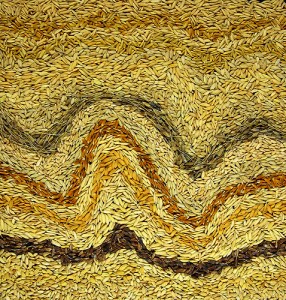- There are 227 bee species in New York City. Damn! But not enough known about the work they (and other pollinators) do in natural ecosystems, alas.
- Borlaug home to be National Historic Site?
- Archaeobotanist tackles Old World cotton.
- FAO suggests ways that small farmers can earn more. Various agrobiodiversity options.
- About 400 new mammal species discovered since 1993 (not 2005 as in the NY Times piece). Almost a 10% increase. Incredible. Who knew.
- But how many of them will give you nasty diseases?
- The caribou wont, I don’t think. And by the way, its recent decline is cyclical, so chill.
- Saving the American chestnut through sex. Via the new NWFP Digest.
- “The best thing IRRI can do for rice is to close down and give the seeds it has collected back to the farmers.” Yikes, easy, tiger! Via.
Nibbles: Drought resistant rice, Bees, Bison, Coffee in Kenya, Cassava in Africa, Pigeon pea, Chickens in Uganda, Green ranching in the Amazon, Climate change, Dates, Museums and DNA, Organic, Ecology meet
- “Sahbhagi dhan is drought-tolerant and can survive even if there are no rains for 12 days.”
- Keeping bees in cities. Not as crazy as it sounds.
- More on the problems of the European bison. What is it with the BBC today?
- Coffee berry borer coming to Kenya. Not boring at all.
- Cassava helping Cameroonians and Ugandans.
- ICRISAT pigeon pea a hit in Kenya.
- Ugandan fishermen crying fowl. What is is with allAfrica today?
- No trees were harmed in the making of this beef.
- “How many of the changes we see happening around us are really attributable to climate change.” Pretty good question. In two parts, be sure to catch both, agrobiodiversity comes into the second.
- How to get a date.
- “By using museum specimens to look back in time, we can potentially assess … [human] impact in detail.” And genebanks, don’t forget genebanks, Olivia.
- Organic better after all. Zzzzzzzzzzzzz.
- Fisheries not as bad as was thought after all. But still pretty bad.
- For best results, use perennials in diverse landscapes and no tilling.
Tri-Societies meeting programme revealed
The programme for the ASA-CSSA-SSSA International Annual Meetings in November is up. The genetic resources sessions look very solid, as ever. And the prestigious Calvin Sperling Memorial Lecture is to be given by our friend, colleague and occasional contributor Robert Hijmans on a topic we’ve blogged about often here, climate change and agrobiodiversity.
Rice diversity measured and photographed
I did a quick nibble a few days ago about the OryzaSNP project, in which “[a]n international team of investigators used microarray-based resequencing to look for SNPs in 100 million bases of non-repetitive DNA in the genomes of 20 different rice varieties and landraces.”
They’ve come up with 159,879 single nucleotide polymorphisms, a “gold-standard set of curated polymorphisms” for rice.
As for the 20 varieties used…
“[t]hese varieties, the OryzaSNPset collection, are genetically diverse and actively used in international breeding programs because of their wide range of agronomic attributes,” the authors explained.
But what do they look like? Well, I just found this photograph of their seeds on IRRI’s Flickr page. A nice idea.

Nibbles: Red rice, Drought squared, Slow Food, Coffee, Cassava, Horses, Wheat, Ketchup
- Saving red rice in India. Note comment from Bhuwon.
- India again: “We have not been able to sow rice. Our corn crop has been destroyed by pests. We have nothing to eat. We have nothing to feed our cattle.”
- Morocco: “The farmers started using more subterranean water, but that has almost been used up, putting us on a straight line to desertification.” But, “[r]esearchers have also introduced new varieties of grain that in laboratory tests have proven resistant to water stress or drought.”
- Another Slow Food interview. Zzzzzzzzzz.
- Cuppa weird joe?
- IITA and others save cassava in West Africa.
- Nice photo essay on a thoroughbred stud farm.
- Take the wheat quiz.
- Where is our heirloom ketchup?